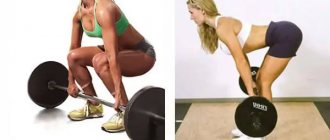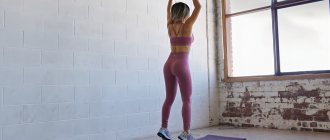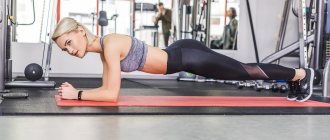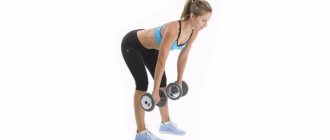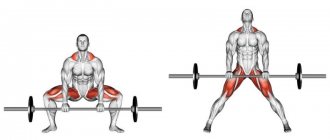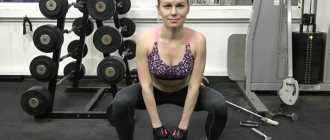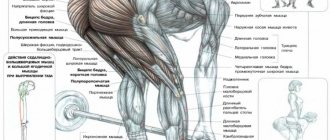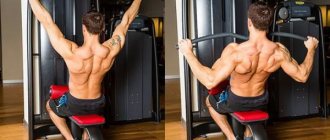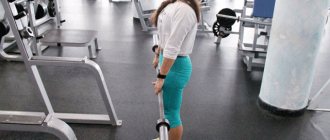Why do deadlifts
This exercise has a lot of advantages. Here are some of them:
- This is a basic exercise for any bodybuilder. It develops several large muscle groups at once (back, legs, buttocks) as well as many small ones. The work of the muscles will be described in detail below.
- Deadlifts can significantly increase your strength. The increase in strength in this exercise will be accompanied by an increase in your muscle mass.
- In some cases, with a sore back, this is an excellent opportunity to forget about pain in the spine forever.
When performing a deadlift, about 70% of the muscles of the entire body are involved in the work. This is a powerful, energy-consuming exercise that also has a functional basis. After all, this is actually lifting a heavy object from the ground. And every person faces this task more than once in his life.
World records for deadlifts in powerlifting[edit | edit code]
World record in deadlift Hafthor Bjornsson - 501 kg (May 2, 2020)
- Hafthor Bjornsson - 501 kg (e) (2 May 2020) - with straps
- Eddie Hall - 500 kg (e) (July 9, 2016) - with straps
- Eddie Hall - 465 kg (w/e) (March 4, 2021) - with straps
- Eddie Hall - 463 kg (w/e) (July 11, 2015) - with straps
- Eddie Hall - 462 kg (w/e) (March 14, 2015) - with straps
- Benedikt Magnusson - 461 kg (b/e) (August 2014) - with straps
- Benedikt Magnusson - 460 kg (b/e) (2011)
- Andy Bolton - 457.5 kg (e) (2009), UK
- Benedikt Magnusson - 442.5 kg (b/e) (2010), Iceland
- Konstantin Konstantinov - 430 kg (e) (2008), Latvia
- Harry Frank - 422.5 kg (2002), USA
- Gary Hazy - 420 kg (1993), USA
- Yuri Belkin - 418 kg (b\e) (2016), Russia
- Mikhail Koklyaev 417.5 kg (b/e) (2010), Russia
- Doyle Kenady - 415 kg (1985), USA
- Mark Henry - 410 kg (b/e) (1996), USA
- Andrey Malanichev - 410 kg (e) (2008), Russia
- Ed Cohen - 409 kg (1995), USA
- Dan Voleber - 408.5 kg (1982), USA
- Tibor Meszaros - 407.5 kg (2002), Hungary
- Aude Wilson - 406.5 kg (1993), USA
- Lars Noren - 406 kg (1987), Sweden
What muscles work
When performing a classic deadlift, the load on the muscles is distributed as follows:
Main working groups:
- Back muscles. The main load falls on the extensors of the spine, especially their lumbar part. Also, part of the work goes to the latissimus dorsi muscles.
- Legs and buttocks. The exercise makes the hamstrings, gluteus maximus and quadriceps muscles actively work. It’s worth saying here that the classic style of deadlifting puts less stress on the buttocks and the back of the thighs, so it is more suitable for men, but, for example, the Romanian deadlift and straight-legged deadlift are traditionally considered a more suitable option for women.
Additional load is received by:
- Forearms and hands. Holding a heavy barbell is not the easiest task for your hands.
- Trapezius muscles.
- Abdominal muscles (rectus and obliques). They stabilize your core, helping you maintain proper, safe posture.
- Calf muscles, inner thighs.
Muscle work during the exercise.
As you can see, almost the entire body is involved in this exercise.
How to learn how to do deadlifts with a barbell correctly?
The “classic” deadlift is traumatic and therefore requires strict adherence to the correct execution technique. Before you include an exercise in your training plan, make sure that your lower back muscles are ready for such a load. To do this, first strengthen them by performing torso bends and hyperextension. Only after this do you start deadlifting, starting with light weights and honing your technique to perfection.
To prepare your muscles, joints and ligaments, be sure to warm up and stretch before starting strength training.
The correct technique for performing classic barbell deadlifts step by step
- Move your shoulders and shoulder blades back a little. Place your legs at shoulder level (approximately at hip level), and touch your shins to the bar. The position of the feet is parallel to each other. The bar passes over the center of the foot (not the center of the forefoot).
- Squat down - move your pelvis back and straighten your back, but do not bring your knees beyond the line of your toes.
- Grab the bar with your hands with a shoulder-width grip (the distance between the hands is 40 cm, the knees are inside the hands). Arms are straight, elbows are fixed. With a classic grip, the palms are turned down.
- Bring your chest and shoulders slightly forward beyond the bar. The gaze is directed straight down. Without swinging or putting your body weight on your toes, lift the barbell by moving your leg muscles - quadriceps and buttocks.
- After the bar has passed 20-30% of the amplitude, straighten your lower back, pushing your pelvis forward, and fix the position. At the point where the weight is lifted, you can push your chest forward (but do not squeeze your shoulder blades together).
- Before lowering the bar, push your hips back so as not to hit your knees with the bar.
- As you move down, keep your spine in a neutral position—do not arch or arch.
- Only after the bar reaches the level of the knees can they be bent.
Sorry, your browser does not support video viewing.
The rules for performing deadlifts are regulated by the International Powerlifting Federation. The lift is performed at the entrance, the bar is lowered as you exhale. Beginners are recommended to perform deadlifts from plates.
Types of deadlifts
The classic way to perform deadlifts was mentioned above. But there are many variations of this exercise.
We list the main ones:
- Classic deadlift performed with a barbell.
- Deadlift of dumbbells on straight legs.
- Deadlift with a barbell.
- Sumo barbell row.
- Short deadlift.
In addition, variations of the barbell exercise can be performed both in Smith and with a free apparatus. The bar can be in a power rack, or simply stand on the floor.
We won't go into depth and tell you about exotic deadlift variations here, because there's no point in that. The exercises given in this article are ideal for all cases.
Common Mistakes
The most common and dangerous mistakes when performing deadlifts with a barbell:
- Arching or arching of the back.
- Legs too wide.
- Arching the back or bending back at the top point or in the starting position.
- The grip of the barbell is too wide and the elbows are spread out to the sides.
- Using weights that are too heavy for a person's current shape.
The most dangerous technical errors are clearly shown in the photo:
Deadlifting in different sports
Unlike powerlifting, the deadlift in bodybuilding is not a 100% mandatory exercise. But it allows you to develop your muscles well, making your body stronger and more respectable. Very famous athletes such as Arnold Schwarzenegger did it regularly. Among lifters, this is the basics.
Craving performed by Arnold Schwarzenegger.
- Deadlifts with a barbell are included in powerlifting triathlons.
- For the barbell push in weightlifting, the deadlift is the basic element of lifting the weight off the floor.
- For wrestlers, this is an important part of training to lift your opponent off the floor.
- This is one of the training elements in rowing.
Mainly, in all sports, this exercise is used to maximally strengthen the lower back.
Warm-up for deadlifts
In any sport, use caution to avoid injury. Under no circumstances should you turn a blind eye to warming up before training, especially when you have just started exercising. Even running, which is so familiar to us, requires stretching our legs in order to reduce the risk of sprain or fracture as much as possible.
Basic exercises with apparatus require both warm-up and backup. And if error-free execution is the first pillar on which your future success rests, then warming up is the second.
Warm-up with small weights
First, stretch your joints and do some exercises. Do a dozen bends, a “mill”, stretch your wrists, elbow and shoulder joints. Next, warm up the tendons in the lower back to avoid tears and strains.
An excellent warm-up option would be stretching.
Do a couple of sets of deadlifts with light weights or an empty bar, and then gradually increase the load. It is also important to perform the exercise slowly, without rushing.
Doing a classic deadlift
Before we tell you how to do a deadlift correctly, let's talk about how to hold a barbell. That is, let's talk about grip.
Grip nuances
The grip can be direct, reverse and mixed (mixed grip).
It is more correct to hold on to the bar so that your hands are turned with your palms facing your belt.
If the weight of the barbell is too heavy, athletes use a type of grip in which one hand is turned as described above, and the other with the palm facing away from you. The so-called mismatch. This really helps keep more weight off. But there are also unpleasant moments in this:
- The symmetry of the body is disrupted; over time, one side may become lower or higher than the other. The difference will be measured in mm, visually you may not notice it. However, this is a curvature of the spine.
- With such a grip (mixed), a torque occurs. The barbell seems to turn in one direction. This moment is transmitted to the spine, loading it.
- You are not training your grip strength because you are using a lighter version.
Correct deadlift technique means that your hands need to be positioned with your knuckles facing outward. If the weight does not allow you to do this, that is, your hands unclench, train your grip strength. There are special exercises for this. Choose a barbell weight that you can hold for 6-8 reps. Slowly increase the load over time.
Exercise technique
The most common option is the classic bent-leg deadlift.
Storyboard of the exercise.
It can be done either in Smith, in a power rack or from the floor. The deadlift is a foundation, so it needs to be done at the beginning of your workout. Warm up well. Stretch your lower back and legs.
- Take an empty bar (usually its weight is 20 kg), stand in front of it, placing your feet slightly narrower than your shoulders. The feet should be parallel to each other.
- Straighten your back, push your pelvis back (natural arch in the lower back). The back cannot be round. The neck is an extension of the back; there is no need to raise or lower your head.
- From this position, we tilt the body forward, moving the pelvis back. With this tilt, the shoulders should extend slightly forward beyond the line of the shins. At the same time, the knees will begin to bend (by 10-15 degrees) - this is normal.
- The tilt of the body should be 40-45 degrees.
- Lower your arms down. If you are bending over correctly, your hands should be in line with the front of your shins.
- There should be very little left to the neck. Crouch down to pick it up. At the same time, do not lean your body forward or backward. Your main task is to ensure that your shoulders move along a strictly vertical axis.
- We take the bar with the correct grip (palms facing us).
- Smoothly straighten your legs, and only then straighten your back. When you hang weights on the bar, you won't have to go as low to grab the barbell. Therefore, you just need to approach it so that the bar rests on your shin. From this position it will need to be raised.
- When you are straight, squeeze your shoulder blades together.
- Then start lowering - first your back bends to about 45 degrees (make sure your shoulders are exactly above the bar), then your legs.
Do 10-15 warm-up reps, then hang up the plates and lift weights for 6-8 reps for 3-4 sets. If the working weight is heavy, approach it gradually. You should not immediately take, for example, 150 kg.
The bar should slide along your legs all the time - first along the shin, through the knee. Next, try not to move it far from the thigh, but also do not press it there with muscle force.
The position of the body, arms and legs during movement.
There is also such a thing as a classic short deadlift. This is when the barbell stands on plates, or is located in a power frame at a certain height from the floor. This option is used to practice This is deadlift training in the upper phase, when we do not lower the weight to the floor. This option is also suitable for people with limited mobility of the hip joints. It is performed in exactly the same way as the regular classic version, the weight is simply set to a higher place. Can be done in Smith.
Notes on technique
There are a number of technical points that should be observed no matter what type of deadlift you are doing. These are the moments:
- Heels should not be lifted off the floor. Do not wear shoes with soft or springy soles. Heavy weights will push them into the floor. It is best to wear shoes with thin, uniform soles (sneakers, for example).
- Despite the fact that when describing the classic deadlift technique, we suggested placing your feet slightly narrower than your shoulders, you need to find your own version. You can place your feet shoulder-width apart, or next to each other. Find the most convenient option for yourself. This will allow you to make the technique most correct for you and your body type.
- Don't load one part of your body more than another during a deadlift. Distribute the load evenly. This is achieved through the correct position of the pelvis. If your back or legs work more, pay attention to your pelvis.
- Take care that the barbell does not roll on the floor. When you lower it during the approach, it should not slide, roll away, etc. In this regard, doing deadlifts in a frame or machine is much more convenient.
- Toes should be on the same line, no leg should protrude beyond this line. Or not reach it. Asymmetry is unacceptable!
- The technique needs to be honed on light weights.
- In Smith, it is more convenient to stand on such a side that when removing the barbell, you can rotate the bar away from you (you are standing in the machine, not in front of it). But, again, do what is most convenient for you.
- To avoid chafing your knees, use bandages. Or do deadlifts in your pants. The wounds take a long time to heal and interfere with training.
- Wear an athletic belt.
Execution in Smith
Smith makes deadlift training a lot easier.
- Firstly, the weight can be taken from different levels.
- Secondly, you can fix it at any point if it suddenly becomes difficult or painful.
- Thirdly, it goes strictly up and down, so you cannot lift it any other way, to the side.
Agree - there are a number of advantages. Perfect for people with back pain.
How to deadlift in Smith - exactly the same as outside the machine. However, do not forget that you should not do deadlifts in Smith all the time. You should try to gradually switch to free weights.
In the Smith machine.
A healthy person does not have to start mastering deadlifts with Smith.
If preparation allows, it is better to immediately take the barbell. It is better to use the simulator for those who have any problems with the spine. More on this a little further.
Basics of exercise technique
Professional bodybuilders perform classic deadlifts. The exercise is done in a Smith, power rack or from the floor. The deadlift is a compound exercise, so it is performed at the beginning of your workout. When performing the exercise, your feet should be flat so that there is good support on the floor. You need to know that a large load is applied to lower the barbell, as when lifting it.
It is almost impossible to indicate the exact angle at which you will need to bend your knees. Each person has their own skeletal structure, and the specific indicator depends on the length of the arms and torso. Throughout the entire exercise, the head, shoulders and pelvis should be located at approximately the same level from each other.
Do not lift the barbell with a sharp jerk. This is due to the fact that when bending your arms at the elbow joint, there will be more load on the lower back. As a result, you can break your back because of the exercise. If a smooth rise is not possible, then you need to remove several pancakes.
Deadlift and sumo
Let's briefly go over the differences between these types of deadlifts and the classic ones. You can read in detail about the technique and features of each exercise in the relevant articles on our website.
Straight-legged row or deadlift
You can perform this exercise with dumbbells or a barbell. Here you will need a good stretch in the lower back and hamstrings. Take care of this in advance. Deadlifts on straight legs are better suited for girls, as they perfectly work the buttocks, back of the thigh and lower back without affecting the quadriceps.
On straight legs.
How to do deadlifts on straight legs - read a separate article on our website.
This is a lighter version of the deadlift, so you can do 10-12 repetitions in 3-4 sets.
If you take dumbbells, you need to hold them on the outside of your thigh. Their necks are parallel to your feet. And the feet are parallel to each other.
If your stretching is not enough to perform this exercise correctly, it is recommended to take a closer look at the Romanian deadlift. When performing it, the pelvis is also moved back, but the legs remain slightly bent at the knees. The bar of the bar drops to the middle of the shin.
Romanian version with slightly bent legs.
Sumo deadlift
This is a lifting type of exercise in which the legs are placed significantly wider than the shoulders and the arms are placed between them.
The wide leg deadlift is used in powerlifting.
In general, the technique is similar to the classic version, but there are a number of differences, which are also described in detail in the corresponding article.
Types and technique of execution
Next we will dwell in detail on the types of deadlifts, of which there are much more than an inexperienced athlete might think. Let's start, of course, with the classic version.
Classic deadlift
The classic version of the deadlift is perhaps the most common in crossfit, extreme strength training and powerlifting. There is no exact information about what sports discipline it originated in, but most likely it was weightlifting - the first part of the push represents precisely this movement.
So, how to do deadlifts correctly step by step (execution technique):
- With a classic deadlift, the athlete grabs the bar shoulder-width apart, his legs are slightly narrower, and his feet are parallel to each other.
- The bar of the barbell is pushed as close as possible to the shins, so it is recommended to use gaiters when performing deadlifts.
- The shoulder blades and shoulders are pulled back slightly.
- The movement begins with the movement of the legs - the bar must be “torn off” with the force of the quadriceps and buttocks. When the bar has passed 20-30% of the amplitude, the athlete should begin moving with his back, fully straighten at the waist and lock in the final position.
A short video with the deadlift technique:
Most of the load in the classic deadlift falls on the back muscles (namely, the spinal extensors and trapezius muscles), so this option is recommended for athletes whose back muscles predominate over the leg muscles. There are also a number of anatomical features of the body’s structure (for example, long arms or a short torso), in which it is worth performing classic deadlifts.
The main mistake beginners make here is rounding their back when lifting (hump row). By doing this, you risk getting a serious back injury and forgetting about athletic longevity.
Pay careful attention to practicing the correct exercise technique so you can get the most out of this movement.
Detailed video about the correct execution of the classic deadlift, analysis of typical mistakes of beginners:
Sumo deadlift
With a sumo deadlift, the load shifts more to the quadriceps and hip adductors. The latissimus dorsi, spinal extensors and abdominal muscles bear more of a static load, since extension in the lumbar region is much less than in the classic version.
When doing sumo deadlifts, the athlete grabs the bar slightly narrower than shoulder level, and, on the contrary, places his legs wider. How wide depends on the level of stretch. It is clear that the wider the legs are, the shorter the amplitude will be, and, therefore, the higher the result will be, however, if you do not have sufficient stretching, if you place your legs too wide, you risk getting a sprain or tear of the adductor muscles. Therefore, it is recommended to start with a medium foot position (slightly wider than shoulder width) and gradually increase it, while not forgetting to pay special attention to stretching.
The movement in the lower back during the sumo deadlift is minimal; we do not need to “bend” with the barbell, as with the classic version. We need to lift it with maximum effort from the leg muscles, without rounding the back or leaning forward.
The most common mistake beginners make when performing sumo deadlifts is moving too much in the back. At the lowest point, they lean over the barbell and tear it off with the simultaneous effort of their back and legs. This is fundamentally wrong: when doing sumo deadlifts, we engage our backs only in the upper part of the amplitude (approximately the last 20% of the movement), working with serious weights. If it is more convenient for you to transfer part of the load to the lower back, it is better to perform deadlifts in the classic version, pay sufficient attention to developing the technique, and personal records will not take long to arrive.
The sumo deadlift is more suitable for athletes with well-developed legs and buttocks. Great for athletes with long torsos and short arms.
Deadlift on straight legs (Romanian deadlift)
The Romanian deadlift has nothing in common with powerlifting, but is an excellent isolation exercise for developing the glutes and hamstrings. The movement is performed on straight legs and with a fixed back by moving the buttocks back. Working in such an amplitude, the biceps of the thigh stretches perfectly in the positive phase of the movement and contracts in the negative phase.
In this exercise, the neuromuscular connection is primary, and not the weight being lifted, so I do not recommend performing straight-legged deadlifts with heavy weights unless you feel an accentuated load on the desired muscle groups. In addition, when working with heavy weights, there is a risk of damaging the hamstrings, which stretch as the pelvis moves back. This can stop your progress in the squat and deadlift as it will take at least a few weeks to recover.
Smith machine deadlift
This is not the most common exercise, however, it has obvious advantages. The Smith machine gives us the opportunity to work along a trajectory specified by the joints, so it is easier for us to focus on the biomechanics of movement and “catch” the contraction of the desired muscles.
In addition, in Smith it is very convenient to set the limiters to the desired level and work due to this in a shortened amplitude (performing some kind of traction from the plinths). A shorter range of motion allows us to get used to working with heavier weights, improves grip strength, and prepares a good foundation for increasing strength in the deadlift and other basic exercises.
Deadlift with trap bar
If your gym is equipped with a trap bar, rejoice! In Russia this is very rare, but in vain, because this bar allows us to work in a slightly different amplitude and increase our strength indicators. The trap bar has the shape of a diamond, inside of which there are handles for gripping. The palms are parallel to each other, and the handles themselves are at the level of the body, making it much easier to keep your back straight throughout the lift, which many people lack when performing classic deadlifts.
Here is a detailed description of the technique for performing deadlifts with a trap bar.
Deadlift with dumbbells
An obvious advantage in working with dumbbells is a longer amplitude, since the dumbbell bar will be located below the barbell bar. Therefore, deadlifts with dumbbells have a place in the training process of a CrossFit athlete, since it is convenient to combine them with dumbbell push-ups or thrusters.
In addition to the semblance of the classic deadlift, there is an exercise called “plie squats”, which is popular among many girls who are interested in fitness. The movement is similar to a sumo-style deadlift, however we do not place dumbbells on the floor and work without stopping in the top position in a shortened amplitude, keeping the hip adductors in constant tension. The back should be kept straight throughout the entire exercise, the weight of the weight is selected individually, but it should be borne in mind that in such isolated exercises there is practically no point in working less than 10-15 repetitions. Here we work on target muscle groups, and do not set strength records.
If your back hurts
Whether to do deadlifts with a sore back is a controversial issue. Most often, the correct load on the lower back strengthens it, and a person forgets about pain and begins to live a full life. There are many such examples. But this is only with the correct technique and proper selection of scales.
When unqualified trainers get down to business, everything ends badly - a hernia, serious injury, surgery. And then you can’t force a person into the gym.
It is best to consult a sports physician about back pain. Because each case is individual!
You should always focus on your own well-being. There shouldn't be any pain. If your back hurts after every workout (do not confuse muscle and joint pain), try performing partial rows (short rows), or always wear an orthopedic belt with stiffeners. If this does not help, postpone classes until you consult a specialist.
If you have a sore back, the safest option is to use a Smith machine. Work in it for the first month to strengthen the ligaments and muscles of the back.
And remember, an ordinary doctor - neurologist or traumatologist will most often prohibit you from heavy exercise. A sports doctor is a sports doctor to help you continue playing sports. Therefore, if life without a gym is unbearable for you, try looking for such a specialist in your city.
Features of the trap bar in the deadlift
Knowing about the features of the main types of deadlifts, one question still remains - the trap bar. In fact, this is an exercise using a diamond-shaped bar, inside of which there are vertical handles for gripping.
A similar apparatus with a parallel grip makes it possible to lift weights vertically with less effort. That is, it will be much easier to keep your back straight. But in all other respects, the deadlift with a trap bar is identical to the classic technique, except that the bodybuilder is in a diamond shape and uses a parallel grip.
Often there is no such device in gyms, and athletes prefer to use the classics in the form of an Olympic barbell.
Main mistakes and difficulties
Stretching
Poor stretching is always a problem for a bodybuilder. Because of this, your deadlift technique can be severely affected. Moreover, this problem applies to any traction option.
Stretch the back of the thighs.
First you need to stretch your lower back, leg flexors, and calves. We use classic techniques for this:
- We reach the floor with our hands on straight legs. The lower you can go without rounding your back, the better. If you reach for floors with a round back, wean yourself off it. Firstly, this is harmful to the spine, and secondly, the technique of the exercise we are considering requires arching in the lower back.
- We stretch our hands to our feet while sitting on a fitness mat.
- We do stretches for the legs - splits, “reach the floor with your knees” and others.
It may take you a month to stretch enough for the lift.
Libra progress
You notice that the weight becomes light and add more. Progress seems to be going quickly. But for some reason the arch in the lower back disappears, and the back begins to round. You lift 150 kg, but in the upper phase you bring the barbell to the final point by straightening the thoracic spine. And the next day you have a strange pain in your chest. Congratulations - you have developed thoracic osteochondrosis.
More often than not, people do not feel pain and continue to gain weight. This is how serious injuries occur. What's the problem? In quickly hanging pancakes. You need to increase the weights slowly, carefully ensuring that the technique does not suffer.
If it’s easy for you, add 10 kg each workout. When it gets heavier, increase the weight by 2.5 kg. It's long, but effective. The most important thing is the right technique! When deadlifts are performed correctly, you will not get injured and you will gain strength and muscle mass.
Thrust frequency
The optimal training regimen for a bodybuilder is 1 deadlift per week. You can do 2 rows if one of them is with dumbbells, for example, on straight legs. And the second one is classic. If you work with heavy weights, it is better to leave the frequency at 1 time per week. This is because the load on the lower back is very large, both joints and ligaments are loaded. They need time to recover.
If you really want to pump up your back faster, do hyperextension 2 times a week.
Hyperextension for back training.
What to do for beginners?
When performing deadlifts, it is usually difficult for beginners to lift the barbell directly from the floor - the lower the working weight used, the smaller the diameter of the plates and the lower the barbell is. Either use plates with a large diameter, or perform deadlifts from a stand.
Let us remind you once again that bending your back upward (just like trying to control yourself in the mirror) is the easiest way to get injured. This remark is especially relevant when performing deadlifts for girls, since they tend to arch their back not only at the bottom, but also at the top.
Do you need insurance and seat belts?
Straps help lift more weight on a barbell than your arms can support - but they should only be used by professionals, not beginners. The same remark applies to the “different grip” technique, when one palm looks up and the other down.
Such a grip makes it easier to perform deadlifts, so it is permissible only in the very last approaches, when the athlete has little strength left. However, again, beginners are advised to first use a regular grip and adequate weights, learning and honing the correct technique - and only then move on to variations.
***
New Fitseven materials, 5 times a week - in telegram:
- fit7seven
The deadlift is the #1 exercise for the abs, lower back, abs, glutes, and hamstrings. It is important for beginners to include this exercise in their training program, while maintaining the ideal technique and learning to feel the muscles working, and not just chasing weight gain.
Scientific sources:
- Starting Strength, 3rd edition: Mark Rippetoe, Jason Kelly
- How to Deadlift with Proper Form: The Definitive Guide Read, source
Errors
One of the most common mistakes when performing classic deadlifts is straight legs: in this case, there is a very large load on the joints. If the spine is not strictly vertical, displacement of the vertebrae and overstrain of the stabilizer muscles are possible. If the spine is rounded – “hump pull” – back injuries and pinched nerves are also possible.
When doing a classic deadlift, don't place your legs too wide—you should have one foot between them—don't lift the weight by abducting your pelvis, and don't leave your pelvis abducted as you straighten your body.
The main mistakes when doing sumo deadlifts are rounding the back when bending over the bar and leaning forward, as well as a large range of motion of the back.
When lifting heavy weights in the Romanian deadlift, there is a high chance of injuring the hamstrings. When moving down, do not put the weight on your shoulders so as not to injure your joints. Don't look at your feet, as this may disrupt your balance.
When lifting a barbell with a different grip, the axial load on the spine increases and the risk of injury increases. To reduce it, the position of the hands is changed with each approach. If your grip is weak, it is better to use wrist loops or belts instead of a different grip.
